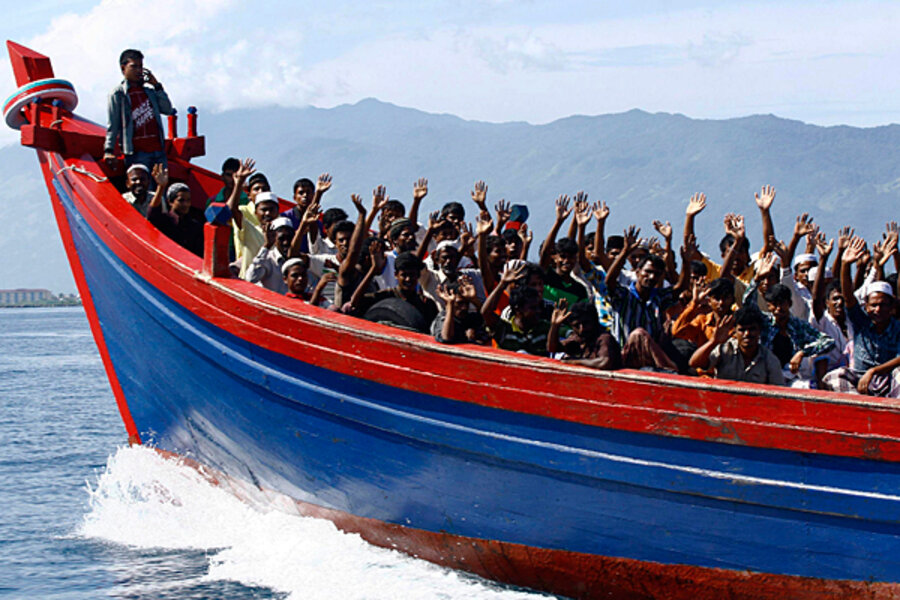Stuck in Indonesia: Asylum seekers before they set sail for Australia
Loading...
| Jakarta, Indonesia
In early 2012 Esi was leading a happy life with his wife and small daughter in a city in central Iran. He had a family he loved and a job as a shopkeeper he was proud of. But his life changed dramatically after police accused him of illegally selling alcohol and changing his religion, two things he denies. They shuttered his shop and threatened to kill him.
Esi scrambled the family’s savings and fled to Malaysia and then Jakarta in the hope of soon reaching Australia. They paid for passage on one of the overcrowded wooden boats illegally shuttling asylum seekers to Australia. The boat floundered and the family ended up back in Indonesia in a detention center.
They took the boat because they were desperate to reach the safety they believed Australia offered. After more than a year stuck in limbo, Esi and his family, like thousands of others, have no idea when they will finally get there.
“When I’m just sitting, waiting, I feel sick,” says Esi, who would only give a nickname because he fears for the safety of his relatives back in Iran. “It’s not a life.”
The number of asylum seekers transiting through Indonesia on their way to Australia has spiked since 2009, straining the country’s detention centers, helping feed the trade in people smuggling, and driving a potential wedge between Jakarta and Canberra.
By August 2013 more than 11,000 refugees and asylum seekers – mostly from Afghanistan, Iran, and Myanmar – were registered with the United Nations High Commissioner for Refugees (UNHCR), compared with 7,945 for all of 2012.
Many live in overcrowded detention centers where they reportedly face abuse. Others, while away the days bored and frustrated in small apartments or shelters waiting, for years in some cases, for the UNHCR to determine their refugee status or process resettlement applications. Only 247 people in Indonesia were resettled in all of 2012.
Because Indonesia has not signed the UN Convention on Refugees it has no obligation to provide asylum seekers with legal protections. The government does not allow them to work and their children can’t enroll in school. While the International Organization for Migration provides some housing and a small monthly stipend of around $125, many asylum seekers have to get by on their own.
“The longer they stay in transit not knowing what’s going to happen to them, the worse it gets,” says Antje Missbach, a research fellow at the University of Melbourne who has studied transit migration in Indonesia.
Those who have some savings or receive remittances live in local communities while they wait. But sometimes they are seen as troublemakers; some unofficially marry Indonesian women and father children. Ms. Missbach says a few communities have appealed to the local and national government to have asylum seekers removed from their villages.
Warm welcome?
Like many here, Esi is hedging his bets that he’ll make it to Australia, despite the fact that he’s unlikely to find a warm welcome there either – particularly if he tries by boat again.
After Australia’s election on Saturday, in which the conservative Liberal-National coalition swept the polls, many say it will become even more difficult for people arriving this way to reach asylum in Australia. The Prime Minister-elect Tony Abbott says one of his first tasks will be to launch Operation Sovereign Borders, a plan under which the military would intercept vessels carrying refugees and push them back into Indonesian waters.
For thousands of desperate asylum seekers, these rickety, overcrowded boats are their last option, even knowing that it’s common for them to sink and countless numbers of passengers have drowned at sea.
The former Australian government put in place a policy where people arriving by boat are sent to centers on Nauru or Manus Island in Papua New Guinea for processing and resettlement to deter this kind of activity.
Critics say the idea of turning back boatloads of people making the journey to Australia is unreasonable.
“People don’t want to stay in Indonesia,” says Dewi Fortuna Anwar, a senior adviser to the Indonesian vice president. “If they get back to Indonesia they will be stuck here in limbo. That will only add to the burden Indonesia has to deal with.”
Despite not signing the UN Convention, officials say Indonesia does provide shelter in detention centers.
Limited capacity
But a report released in June by Human Rights Watch said conditions at Indonesia’s detention centers “fall far short of international standards,” and analysts say Indonesia has limited capacity to detain migrants in the first place, since it lacks trained agents and adequate facilities.
It has also struggled to stop boats from leaving, a problem Ms. Anwar says is too difficult for Indonesia to handle alone. Given Indonesia’s enormous coastline, people smugglers “will still find enough ports and poor fishermen willing to help them.”
Indonesian Foreign Minister Marty Natalegawa has called for cooperation between the destination countries, countries of origin, and transit countries such as Indonesia, to find a regional solution to dealing with the growing number of asylum seekers.
All this political maneuvering, however, appears lost on the dozens of people living in one refugee housing complex in south Jakarta.
After 13 months in Indonesia, Azim Jarafi, his wife, Nasima, and their five children – all ethnic Hazaras – are still waiting for passage to Australia.
“We [were] compelled to leave because we have so many problems in Afghanistan, because of war, because of the Taliban,” says Azim. “We came to Indonesia to go to Australia, not to go back to Afghanistan.”
That’s a familiar sentiment for Esi and his family. Last week they found out their refugee claim was rejected. They have already been through a harrowing, but common journey that involved nearly $20,000 in payments to smugglers and have now landed back in Jakarta.
“My friends said people obey the law in Australia,” says Esi, who puts his hand to his heart when he speaks. “Lots of people are going there these days. We want to be safe, and I believe there we can live peacefully.”
Esi says he will appeal his refugee determination with the UNHCR. If it’s rejected a second time the family will have no choice but to try again by boat. His wife’s dark, almond eyes grow teary as he says this, and his daughter, whose name he has tattooed in primary colors on his forearm, sits on the floor spooning rubber balls into a mug.
“The waiting is destroying us,” he says. “We are like birds in a cage here in Indonesia. Our main purpose is resettlement. If I didn’t have problems in my country I would go back, but I cannot.”








